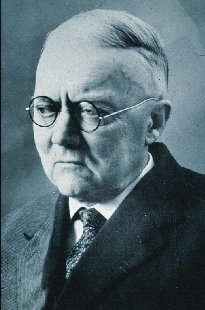Ernst Öpik
Ernst Julius Opik (born October 10 . Jul / 22. October 1893 greg. In Kunda , Governorate of Estonia ; † 10. September 1985 in Bangor , Northern Ireland) was a native of Estonia astronomer .
Live and act
Öpik attended high school in Reval, which was then Russian (today: Tallinn ) and then studied at the Imperial University of Moscow . In 1916 he became director of the astronomical department in Tashkent (Uzbekistan). From 1921 to 1944 he worked at the observatory in Tartu (Estonia), interrupted from 1930 to 1934 by a stay at the Harvard College Observatory . As a former volunteer in the Russian White Army , he fled from the advancing communists in a horse-drawn carriage.
Öpik co-founded the Baltic University in Pinneberg in 1946 and became its first rector. In 1948 he went to Armagh (Northern Ireland), where he worked at the Armagh Observatory until 1981 and was also managing director for some time. From 1950 to 1981 he was also the editor of the Irish Astronomical Journal . Since 1956 he shared his time in Armagh with a visiting professorship at the University of Maryland, College Park . In 1975 he received the gold medal of the Royal Astronomical Society and in 1976 the Bruce Medal . The asteroid (2099) Öpik is named after him. He was a founding member of the Estonian Academy of Sciences (1938) and a member of the National Academy of Sciences (1975), whose J. Lawrence Smith Medal he had received in 1960, and of the American Academy of Arts and Sciences (1977).
Öpik's main research area were small bodies of the solar system such as asteroids, comets and meteors . But also about planet - atmospheres , the internal structure and evolution of stars and other astronomical subjects he gained an early important theoretical insights that often only decades later became widely recognized.
Some significant works:
- In 1915 he calculated the density of a white dwarf star for the first time
- In 1922 he predicted the craters of Mars .
- In 1922 he carried out the first correct determination of the distance of an extra-galactic object (the Andromeda Nebula ).
- In 1932 he put forward a theory about the origin of comets, in which he anticipated the Oort cloud .
- In 1938 he developed a theoretical model of the dwarf stars , from which he derived their transformation into giant stars .
- In 1952 he presented a new theory of the ice ages .
Ernst Öpik's grandson Lembit Öpik is a British politician. His brother was the paleontologist Armin Alexander Öpik (1898–1983). The asteroid (2099) Öpik , discovered in 1977, was named after him.
Web links
- Publications by E. Öpik in the Astrophysics Data System
- Obituaries for E. Öpik in the Astrophysics Data System
- Armagh Observatory: Short Biography of Ernst Julius Öpik
- M. de Groot: Ernst Julius Öpik, 1893-1985 . In: Geodeet . 6, No. 30, 1994, pp. 11-14.
Individual evidence
- ↑ Entry in the baptismal register of the parish of St. Nikolai zu Maholm (Estonian: Viru-Nigula kogudus)
| personal data | |
|---|---|
| SURNAME | Öpik, Ernst |
| ALTERNATIVE NAMES | Öpik, Ernst Julius |
| BRIEF DESCRIPTION | Estonian astronomer |
| DATE OF BIRTH | October 22, 1893 |
| PLACE OF BIRTH | Kunda , Estonia |
| DATE OF DEATH | September 10, 1985 |
| Place of death | Bangor , Northern Ireland |
